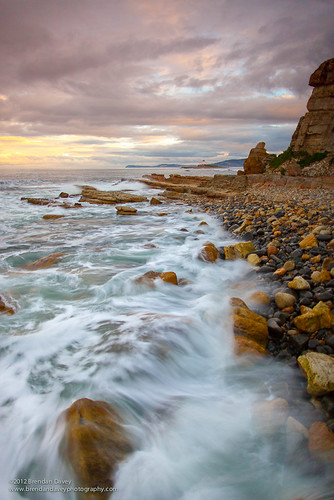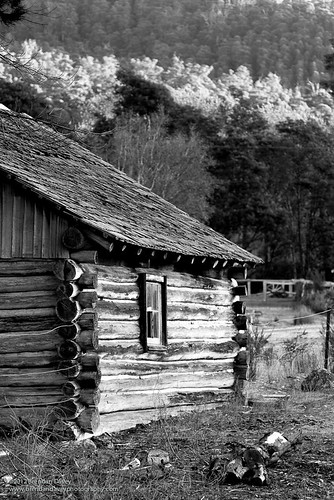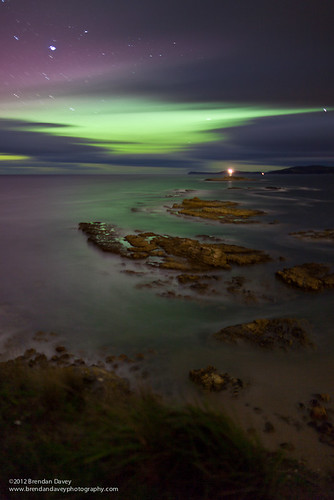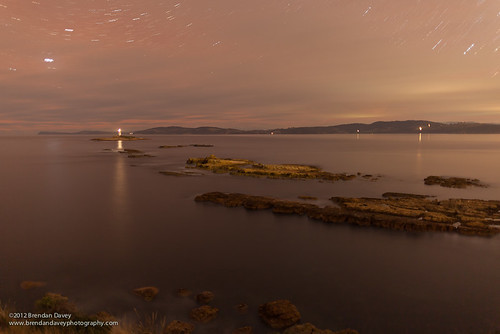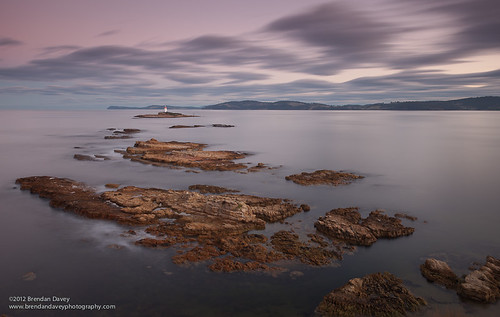Today my Flickr account reached 50,000 all time photo views. Wow, that’s a lot of people looking at my photos, If you are one of those 50,000, THANK YOU!
Remote Tasmania.
It’s surprising just how well some of these old Tasmanian buildings have weathered. I have no doubt there are a few leaks in the roof, but overall I found this building to be in great shape, complete with wood shingled roof and log walls (including the cement / mud filling).
Persistence and Patience
That’s all it takes. Finally I got the Southern Lights over the Iron Pot in Storm Bay. They were not as strong as they had been on Sunday night, and the weather deteriorated very quickly. But I manged to get a few shots before I had to pull the plug.
There were quite a few people trying their luck at the lookout overlooking Betsy Island. I think they had all left it to late (10-12pm), and there was almost nothing left of the Aurora.
Clarence Open Art Comp.
Starting this Tuesday the 17th, two of my works will be on display at The Barn and Schoolhouse Galley, Rosny, next to Eastlands shopping centre.
Until the 9th of August The Clarence Open Art Comp has 270 pieces of artwork on display. all at very reasonable prices, and I would say there would be something for everyone there.
GEOSTAT Alert Fail.
Words you don’t really want to hear when you waiting for an Aurora.
“IPS GEOSTAT ALERT NUMBER 140: GEOMAGNETIC STORM FAILED TO EVENTUATE ISSUED AT 0402 UT ON 11 Jul 2012 BY IPS RADIO AND SPACE SERVICES FROM THE AUSTRALIAN SPACE FORECAST CENTRE”
IPS Space weather is great site for getting alerts and warnings about, well, space weather. 🙂 I must admit trying to get a clear cold night with no moon and the right conditions for a geomagnetic storm to occur all at the same time is quite difficult. Particularly when you need the storm to be big enough to see the aurora from a location 42 Degrees South.
No Green here.
Waiting for the Aurora over the Iron Pot at the mouth of the Derwent River. Just reflected light in the clouds as the night progressed. Maybe tomorrow. Hopefully it will be colder and less cloudy. 🙂
High Mega Pixels, do I need it?
There always has been two schools of thought on just how many mega pixels (MP) you need in a camera. This issue seems to divide the photographic community to no end. In the first camp we have those that are of the opinion ‘I would be happy with just 4-8MP if it was sharp and clear with no noise’, while in the second we have the ‘More MP is better’.
I think both parties are correct, in fact the latter party once they have their high MP camera will use noise and clarity as criteria 2 for deciding on their purchase, or they will be willing to trade off a few MP to get lower noise.
Why do I think both parties are correct?, well it all depends on what you are going to use the photos for. If your printing 8×10’s or using them on a digital picture frame you don’t need anything above 8MP, in fact 2MP is enough for 5×7 or digital frame. 8MP will go to A3 or even A2 size with no problems, there may not be as much detail at that size and the details may be as low as 100 dots per inch (DPI), but at A2 most people don’t examine a picture closely, you must step back to appreciate it. In my opinion 10MP at A1 is acceptable for most subject matter. Most wedding photographers for example have 99% of there prints done at 8×10 or less, so 8-10MP is more than enough.
Why should I get a high MP camera then? Well it all depends on your subject matter. I mainly shoot landscapes, and I print them very large, A1, A0 or bigger. At these sizes with this subject matter people like to get up close and look at the finer details in pictures, ‘what is that? is it a shell?’. I have printed 21MP images up to 2m wide and at this size I would consider it the limit for my type of subject matter. Most serious landscape photographers printing at very large sizes are still using medium format or large format film and having them converted to digital, providing them with 40-80MP of data for medium format, and more for large format. It is also fair to say that if shown a 10MP A1 image next to a 21MP A1 image you could tell which one is of higher clarify. The question you must ask yourself is, will I be printing at A2+ sizes? and if that 1 in 1000 shot is going to be at that size, would I be happy with the clarity? How close will people be viewing the picture?
If your print was printed to billboard size you would not walk up and look at it from 1 foot away would you? most billboards pictures are as low as 10DPI.
Print size and viewing distance are the most important factors when considering how many MP you need.
Optimal Viewing Distance: Viewing Distance = 1.5 x Diagonal of the Print.
The DPI or pixels per inch (ppi) needed for a print with acceptable quality is determined by dividing 3438 by the viewing distance.
| Megapixels | Pixel Dimensions |
Size | PPI Needed |
Actual PPI |
Print Quality |
|
| 6 | 3008 x 2000 | 4″ x 6″ | 313 | 501 | Excellent | |
| 8″ x 12″ | 156 | 251 | Excellent | |||
| 16″ x 24″ | 80 | 125 | Excellent | |||
| 7 | 3072 x 2304 | 4″ x 6″ | 313 | 512 | Excellent | |
| 8″ x 12″ | 156 | 256 | Excellent | |||
| 16″ x 24″ | 80 | 128 | Excellent | |||
| 8 | 3264 x 2448 | 4″ x 6″ | 313 | 544 | Excellent | |
| 8″ x 12″ | 156 | 272 | Excellent | |||
| 16″ x 24″ | 80 | 136 | Excellent | |||
| 10 | 3888 x 2592 | 4″ x 6″ | 313 | 648 | Excellent | |
| 8″ x 12″ | 156 | 324 | Excellent | |||
| 16″ x 24″ | 80 | 162 | Excellent |
As you can see 10MP is more than enough to print to 16×24 at over twice the acceptable PPI for the normal viewing distance.
See this article for more information about print size and view distance.
There are other considerations to take into account when determining the best PPI, these include: Viewing conditions, Delivery Media (Paper, Canvas, Digital Frame), Subject Matter, Noise (grain) and Brightness. Once you have the required MP for your subject and media, the next most important factor is noise or ISO performance, and this like MP is determined by the camera, all of the other points listed above the photographer has some control over except MP and noise. You can’t add MP, or improve the noise the sensor will create (without changing your exposure or shooting style), and this is why the two groups in photography are more MP and/or better noise at higher ISO’s.
So in conclusion if your printing normal subject matter at normal sizes to be viewed at a normal distance an entry DSLR will be more than enough, especially considering you would be struggling to buy a new camera with less than 14MP. If your going to want to do larger prints where the viewing distance may by varied or closer than normal then get a larger MP camera, or consider a medium format camera.
Autumn
One for each season…. The last in a series of four prints, each based on a season of the year.
$995.00 Mounted print on canvas, 800mm x 800mm, UV and protective coating.
The Trees.
An older picture from Mt Field National Park in Tasmania, converted to highlight the lighting and mood of the forest. In this picture I have re-introduced some of the bark texture.
This brings this series to 4 pictures, which cover in general the four seasons.
$995.00 On Canvas @ 800mm x 800mm, UV and protective coated.
Sunset in NZ
I have been trying a few artistic modifications on some pictures recently, not all shots work, but I think this one pulls it off quite well, providing the colours from the original photo, but less details, leaving only the mountains and distant treeline as a place to focus your eye upon. Instantly your eyes are drawn to the mountains.
I will be making this one available for purchase, $995 @ 800mm x 800mm on canvas, coated and UV treated.
